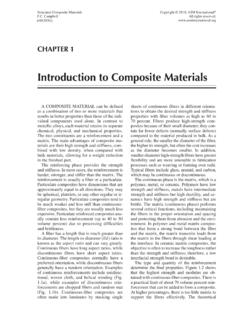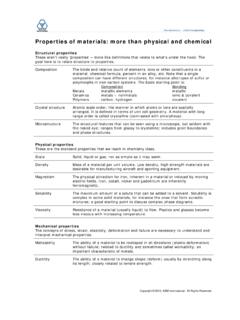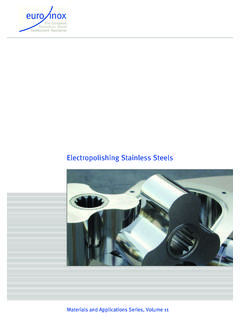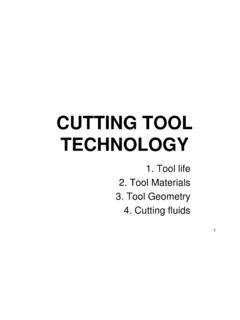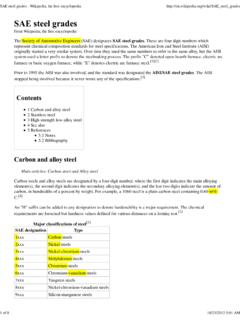Transcription of High-Speed Tool Steels - ASM International
1 tool Steels Alan M. Bayer and Bruce A. Becherer, Teledyne Vasco High-Speed tool Steels and their requirements are defined by The American Society for Testing and Materials in Speci- fication A600-79 as follows: High-Speed tool Steels are so named primarily because of their ability to machine materials at high cutting speeds. They are complex iron-base alloys of carbon, chromium, vanadium, mo- lybdenum, or tungsten, or combinations thereof, and in some cases substantial amounts of cobalt. The carbon and alloy contents are balanced at levels to give high attainable hardening response, high wear resistance, high resistance to the softening effect of heat, and good toughness for effec- tive use in industrial cutting operations.
2 Commercial practice has developed two groups of cutting materials: The recognized standard High-Speed tool steel , which serves almost all applica- tions under mild to severe metal-cutting conditions A smaller group of intermediate Steels , which are satisfactory for limited applica- tions under mild to moderate metal-cut- ting conditions The minimum requirements that must be met to be classed as a standard High-Speed tool steel , and those for an intermediate High-Speed tool steel , are listed in Table I. To be acceptable for either group, an alloy must meet all of the requirements shown for that group.
3 A chronology of some of the significant developments in High-Speed tool Steels is given in Table 2. The research work in 1903 on a 14% tungsten alloy led to the develop- ment of the first High-Speed tool steel , which is now designated Tl. M and T Classification There are presently more than 40 individ- ual classifications of High-Speed tool Steels , according to the American Iron and steel Institute (AISI). When these are compound- ed by the number of domestic manufactur- ers, the total number of individual Steels in the High-Speed tool steel category exceeds 150.
4 The AISI established a classification system for the High-Speed tool Steels many years ago. That system consists of a T for those Steels that have tungsten as one of Table 1 Requirements for High-Speed tool Steels per ASTM A 600 Requirement Standard Intermediate Chemical requirements Minimum alloy content by major elements Carbon .. Chromium .. Vanadium .. Tungsten + Minimum total alloy content based on tungsten equivalents (t/3 Cr + V + W+ Mo) Grades containing less than 5% cobalt .. Grades containing 5% or more cobalt.
5 Hardening response requirements Ability to be austenitized, and tempered at a temperature not less than 510 C (950 F) with a fine-grain structure (Snyder-Graff grain size 8 min) to .. 63 HRC 62 HRC their primary alloying elements and an M for those Steels that have molybdenum ad- ditions as one of their primary alloying elements. In addition, there is a number that follows either the M or the T. Thus, there are High-Speed tool Steels designated M l, M2, M41, T l, T I5, and so on. That number does not have any special significance other than to distinguish one from another.
6 For example, M I does not mean that it is more highly alloyed than M2 or has greater hard- enability or poorer wear resistance, and so on. It merely separates the types and at- tempts to simplify selection for the user. Table 3 lists the nominal analyses of the common M and T types. Effect of Alloying Elements The T series contains 12 to 20% tungsten, with chromium, vanadium, and cobalt as the other major alloying elements. The M series contains approximately to 10% molybdenum, with chromium, vanadium, tungsten, and cobalt as the other alloying elements.
7 All types, whether molybdenum or tungsten, contain about 4% chromium; the carbon and vanadium contents vary. As a general rule, when the vanadium content Table 2 Significant dates in the development of High-Speed tool Steels Date Development 1903 .. C, 14% W, 4% Cr prototype of modem High-Speed tool Steels 1904 .. V addition 1906 .. Introduction of electric furnace melting 1910 .. Introduction of first 18-4-1 composition (AISI Tl) 1912 .. 3 to 5% Co addition for improved hot hardness 1923 .. 12% Co addition for increased cutting speeds 1939.
8 Introduction of high-carbon high-vanadium super High-Speed tool Steels (M4 and Tl5) 1940-1952 .. Increasing substitution of molybdenum for tungsten 1953 .. Introduction of sulfurized free-machining High-Speed tool steel 1961 .. Introduction of high-carbon high-cobalt super hard High-Speed tool Steels (M40 series) 1970 .. Introduction of powdered metal High-Speed tool Steels 1973 .. Addition of higher silicon/nitrogen content to M-7 to increase hardness 1980 .. Development of cobalt-free super High-Speed tool Steels 1982 .. Introduction of aluminum-modified High-Speed tool Steels for cutting tools is increased, the carbon content is usually increased (Ref l).
9 The tungsten type T l does not contain molybdenum or cobalt. Cobalt-base tung- sten types range from T4 through T l5 and contain various amounts of cobalt. Molybdenum types MI through MI0 (ex- cept M6) contain no cobalt, but most con- tain some tungsten. The cobalt-base, mo- lybdenum-tungsten, premium types are generally classified in the M30 and M40 series. Super High-Speed Steels normally range from M40 upward; they are capable of being heat treated to high hardnesses. The M series Steels generally have higher abrasion resistance than the T series Steels and less distortion in heat treatment; also, they are less expensive (Ref 2).
10 Tools made of High-Speed tool steel can also be coated with titanium nitride, titanium carbide, and numerous other coatings by physical vapor deposition technique for improved perfor- mance and increased tool life. ASM Handbook, Volume 16: Machining ASM Handbook Committee, p 51-59 Copyright 1989 ASM International All rights reserved. 52 / Cutting tool Materials Table 3 Composition of High-Speed tool Steels AIS! type UNS designation C Si Cr V W Mo Co Molybdenum High-Speed tool Steels MI .. T11301 M2 Regular C .. T11302 High C.








